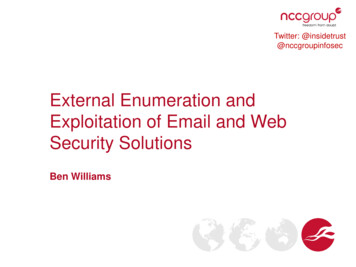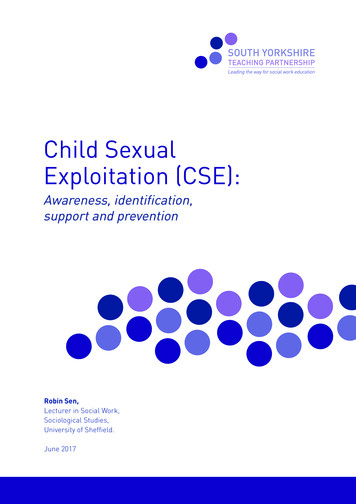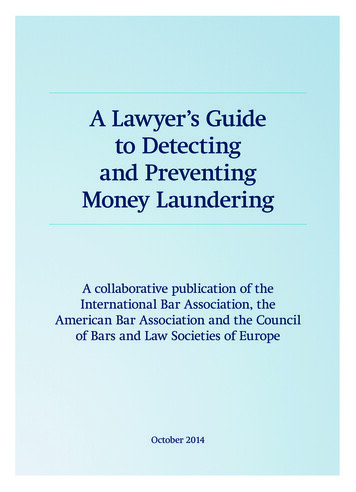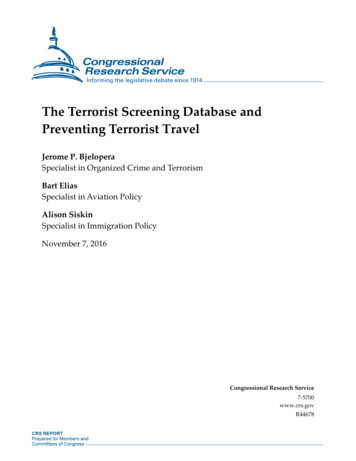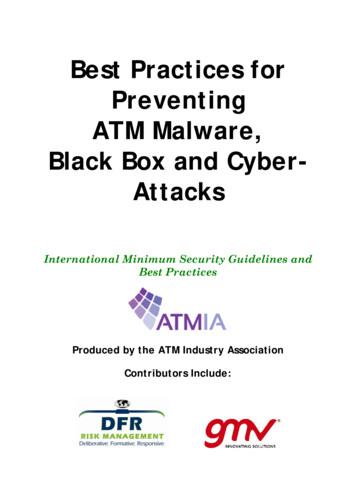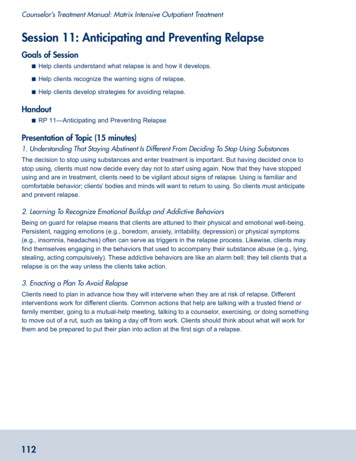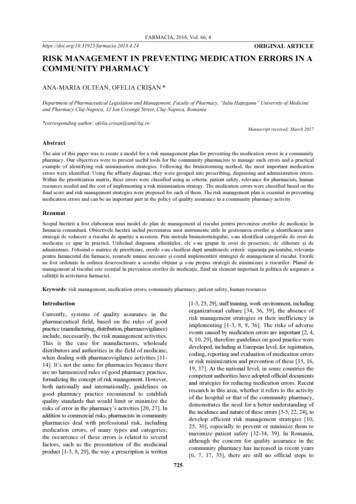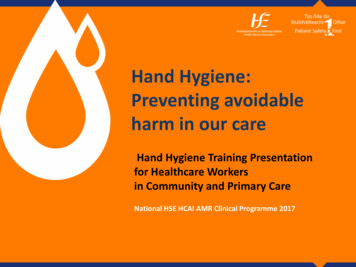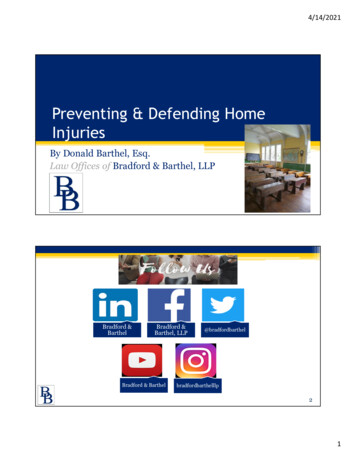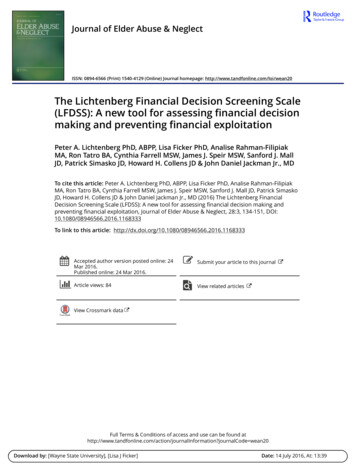
Transcription
Journal of Elder Abuse & NeglectISSN: 0894-6566 (Print) 1540-4129 (Online) Journal homepage: http://www.tandfonline.com/loi/wean20The Lichtenberg Financial Decision Screening Scale(LFDSS): A new tool for assessing financial decisionmaking and preventing financial exploitationPeter A. Lichtenberg PhD, ABPP, Lisa Ficker PhD, Analise Rahman-FilipiakMA, Ron Tatro BA, Cynthia Farrell MSW, James J. Speir MSW, Sanford J. MallJD, Patrick Simasko JD, Howard H. Collens JD & John Daniel Jackman Jr., MDTo cite this article: Peter A. Lichtenberg PhD, ABPP, Lisa Ficker PhD, Analise Rahman-FilipiakMA, Ron Tatro BA, Cynthia Farrell MSW, James J. Speir MSW, Sanford J. Mall JD, Patrick SimaskoJD, Howard H. Collens JD & John Daniel Jackman Jr., MD (2016) The Lichtenberg FinancialDecision Screening Scale (LFDSS): A new tool for assessing financial decision making andpreventing financial exploitation, Journal of Elder Abuse & Neglect, 28:3, 134-151, DOI:10.1080/08946566.2016.1168333To link to this article: epted author version posted online: 24Mar 2016.Published online: 24 Mar 2016.Submit your article to this journalArticle views: 84View related articlesView Crossmark dataFull Terms & Conditions of access and use can be found tion?journalCode wean20Download by: [Wayne State University], [Lisa J Ficker]Date: 14 July 2016, At: 13:39
JOURNAL OF ELDER ABUSE & NEGLECT2016, VOL. 28, NO. 3, 168333The Lichtenberg Financial Decision Screening Scale(LFDSS): A new tool for assessing financial decision makingand preventing financial exploitationDownloaded by [Wayne State University], [Lisa J Ficker] at 13:39 14 July 2016Peter A. Lichtenberg, PhD, ABPPa,b, Lisa Ficker, PhDa, Analise Rahman-Filipiak, MAa,b,Ron Tatro, BAc, Cynthia Farrell, MSWd, James J. Speir, MSWe, Sanford J. Mall, JDf,Patrick Simasko, JDg, Howard H. Collens, JDh, and John Daniel Jackman Jr., MDiaInstitute of Gerontology, Wayne State University, Detroit, Michigan, USA; bDepartment of Psychology,Wayne State University, Detroit, Michigan, USA; cCenter for Elder Rights Advocacy, Elder Law ofMichigan, Lansing, Michigan, USA; dAging and Adult Services, Adult Protective Services, State ofMichigan Department of Health and Human Services, Lansing, Michigan, USA; eSpeir Financial Services,Southfield, Michigan, USA; fMall, Malisow and Cooney, PC, Farmington Hills, Michigan, USA; gSimaskoand Simasko Law Firm, Mount Clemens, Michigan, USA; hGalloway and Collens, PLLC, HuntingtonWoods, Michigan, USA; iPrivate Practice Cardiologist (Ret.), Tyler, Texas, USAABSTRACTKEYWORDSOne of the challenges in preventing the financial exploitationof older adults is that neither criminal justice nor noncriminaljustice professionals are equipped to detect capacity deficits.Because decision-making capacity is a cornerstone assessmentin cases of financial exploitation, effective instruments formeasuring this capacity are essential. We introduce a newscreening scale for financial decision making that can be administered to older adults. To explore the scale’s implementationand assess construct validity, we conducted a pilot study of 29older adults seen by APS (Adult Protective Services) workersand 79 seen by other professionals. Case examples areincluded.Financial decision making;financial exploitation;financial judgment;protective servicesAn 82-year-old man with undiagnosed vascular dementia gets caught up in the“grandparent scam,” in which someone purporting to be a grandchild asks formoney to get themselves out of legal trouble overseas, and over the course of 1week he wires money from his bank account five times and loses 100,000. An84-year-old man with mild to moderate Alzheimer’s disease can no longermanage his money or even shop at the local grocery store, but when taken to abank he signs a notarized reverse mortgage and loses 240,000 to his handyman—who, unbeknownst to the man’s family, has secretly befriended him over theprevious 6 months. And a 79-year-old man with undiagnosed dementia losesmore than 2 million over a 14-month-period to his late wife’s former caregiver.In this case, Adult Protective Services (APS) visited him four times and took hisword each time that he knew what he was doing—without taking any steps toCONTACT Peter A. Lichtenberg PhD, ABPP,p.lichtenberg@wayne.eduInstitute of Gerontology andDepartment of Psychology, Wayne State University, 87 E. Ferry Street, Detroit, MI 48202, USA. 2016 Taylor & Francis
Downloaded by [Wayne State University], [Lisa J Ficker] at 13:39 14 July 2016JOURNAL OF ELDER ABUSE & NEGLECT135assess his capacity for financial decision making. As these types of cases becomeincreasingly common, the criminal justice system and financial services industryattempt to better detect financial incapacity and exploitation.Did these older individuals understand their decisions and appreciate theirimpact? It appears that they did not. But more importantly, how would abanker or APS worker in the above scenarios know without having any wayto assess the older adult’s capacity? Until now, no assessment measurescapable of being administered in the field by APS and other professionalshave been available.To address this critical gap, we have created a screening scale designed toassess decisional ability at the point at which an older adult is making asignificant financial decision. This brief screen can be used by financialprofessionals and others (e.g., an APS worker called to investigate potentialexploitation or a banker being asked to transfer large amounts of cashoverseas). We will introduce the conceptual bases for our scale and provideempirical evidence for the scale’s criterion-related and construct validity.Before introducing our 10-item scale, however, it is important to place itwithin the context of current measurement approaches to financial exploitation and to describe the full-length, 77-item Lichtenberg Financial DecisionRating Scale (Lichtenberg, Stoltman, Ficker, Iris, & Mast, 2015) from whichthe screening questions were derived. In addition, we provide an overview ofthe cognitive factors, and particularly cognitive decline, associated withfinancial decision making.The approach we use is novel in the field of financial exploitation, in that weexamine the phenomenon by focusing on the older adult’s decision-makingprocess as it applies to a single financial decision the individual is considering(as opposed to a hypothetical scenario, which has traditionally been used toassess financial competency). It is not, however, without precedent. Dong(2014) argues that accurate assessment of financial capacity—and financialdecision-making capacity in particular—is the cornerstone assessment inmany cases of financial exploitation. We acknowledge that this focus ondecisional capacity does not cover all forms of exploitation (e.g., identity orother theft), but in many cases of financial exploitation, examination of anolder adult’s financial decision-making process presents a unique opportunityfor intervention and, ideally, prevention.The dramatically increasing number of older adults in America underscores the fact that the cognitively impaired population will close to tripleover the next 35 years (Hebert, Scherr, Bienias, Bennett, & Evans, 2003). Thecollision between an increasingly older population with high prevalence ofcognitive impairment (Plassman et al., 2008) and frailty (Bandeen-Rocheet al., 2015) and those seeking to exploit them financially is rapidly increasing(Lichtenberg, Sugarman, Paulson, Ficker, & Rahman-Filipiak, in press).Pillemer, Connolly, Breckman, Spreng, and Lachs (2015) summarize data
136P. A. LICHTENBERG ET AL.Downloaded by [Wayne State University], [Lisa J Ficker] at 13:39 14 July 2016that indicate that the presence of dementia or cognitive impairment isassociated with increased prevalence of elder abuse, and Stiegel (2012) hasfound that financial capacity and financial exploitation are connected.Specifically, older adults’ vulnerability is twofold: (a) the potential loss offinancial skills and financial judgment, and (b) the inability to detect, andtherefore prevent, financial exploitation. Money lost by older adults due tofinancial exploitation is rarely recovered, and if large amounts of money areinvolved, the older adult has few means to recover from the loss. Preventingfinancial exploitation, therefore, is a critical need.Literature ReviewFinancial exploitation and the measurement of decision-making capacityThe most comprehensive measure to date for assessing financial exploitationis a self-report instrument, the Older Adult Financial Exploitation Measure(OAFEM; Conrad et al., 2011; Conrad, Iris, Ridings, Langley, & Wilber,2010). Carefully constructed and later validated against cases substantiatedby APS workers, Conrad and colleagues (2010, 2011) define the financialexploitation of older adults as the illegal or improper use of an older adult’sfunds or property for another person’s profit or advantage. They propose sixdomains of financial exploitation: (a) theft and scams, (b) abuse of trust, (c)financial entitlement, (d) coercion, (e) signs of possible financial abuse, and(f) difficulty managing money.The OAFEM is a yes/no questionnaire designed to assess whether theolder adult has been victimized by any of the forms of financial exploitationnamed above. For example, question #47 asks whether the older adult hasbeen the victim of a scam that involved giving to a bogus charity. These andother questions are excellent for identifying the areas to investigate, andwith a nondefensive and reflective older adult, the answers are likely to bevaluable for substantiating past or ongoing abuse. Because the scale isdesigned to measure how much exploitation has taken place in the past,however, it does not assess current performance-based financial judgmentor decision-making capacity, such as understanding the consequences of apending financial decision. As a result, older adults who are not aware thatthey are being victimized, due to emotional manipulation and/or cognitiveimpairment, may not give an accurate self-report.These deficits in financial decision-making abilities are often the hiddenelement in financial exploitation cases. Other researchers have measuredaspects of elders’ financial decision-making ability through assessment offinancial literacy and hypothetical scenarios (Boyle et al., 2012; James,Boyle, Bennett, & Bennett, 2012). Financial literacy is interpreted as theability to perform simple calculations (e.g., add up purchases and interest
Downloaded by [Wayne State University], [Lisa J Ficker] at 13:39 14 July 2016JOURNAL OF ELDER ABUSE & NEGLECT137rates), and knowledge of financial concepts such as stocks, bonds, andcompound interest, which the authors acknowledge may not apply to seniorswith limited education (Boyle et al., 2012). Hypothetical financial situationsare designed to simulate (a) the resources and documents used in real-worldfinancial settings (e.g., checkbook management) and (b) making an investment decision based on a scenario (James et al., 2012; Marson et al., 2000).The above tools are useful when conducting a comprehensive assessment butwould not be practical when the older adult is weighing an actual financialdecision. In contrast, the brief screen we propose combines evaluation forpotential financial exploitation and assessment of decisional abilities, and it isintended for use in the context of a significant real-life financial decision.Marson (2001) conceives of financial capacity as relating to three things:(a) specific financial abilities, (b) broad domains of financial activity, and (c)overall financial capacity. In his 2001 study, for example, financial capacitywas strongly linked to stages of Alzheimer’s disease. In subsequent studies,Marson and colleagues have employed the eight-domain Financial CapacityInstrument (FCI; see Martin et al., 2008 as an example), including assessments of basic monetary skills, financial knowledge, cash transactions, checkbook management, bank-statement management, financial judgment, billpayment, and knowledge of personal assets and estate arrangements.One significant weakness of the FCI is that it uses neutral or hypotheticalstimuli (e.g., “How could you be sure the price of a car is fair?”). Yet validand reliable tools are essential if we are to adequately assess financialdecision-making abilities specific to the individual at risk, especially regaringsentinel financial transactions, which are defined as transactions that mayresult in significant losses or harmful consequences.Cognitive decline and financial decision makingSeveral recent studies have investigated financial decision making in couplesin which one person shows cognitive decline. Study findings demonstrate thevalue of an assessment tool that offers protection where needed, but alsosupports autonomy whenever possible. Over a 10-year period, Hsu and Willis(2013) examined financial management in couples in which one party hadcognitive deficits, and found that cognitive impairment, rather than cognitivechange, was related to greater financial difficulties. Indeed, difficulties withmoney often preceded the turning over of financial control from the cognitively impaired spouse to the unimpaired spouse, which was usually relatedto pending decisions about self-directed financial investments. Even so, 33%of financial respondents in the study continued to be the primary financialdecision maker, despite having cognitive scores in the dementia range. Thesedata underscore the heterogeneity in how couples cope when the primaryfinancial decision maker becomes cognitively impaired, and demonstrate that
Downloaded by [Wayne State University], [Lisa J Ficker] at 13:39 14 July 2016138P. A. LICHTENBERG ET AL.is not unusual for older adults with cognitive impairment to be placed in adecision-making role, even when other options are available.Boyle and colleagues (2012) examined how cognitive abilities beforedementia onset predicted financial decision making 5 years later, andfound (using hypothetical mutual fund options) that more rapid cognitivedecline led to poorer decision-making abilities, even in participants with mildcognitive impairment. These results are consistent with Marson et al.’s (2009)research on financial capacity. Marson (2001) (also see Marson et al., 2009)argues that the impact of age-related dementia (e.g., Alzheimer’s disease) onfinancial capacity is one of the biggest challenges to financial autonomy.Although cognitive functioning is an important predictor of decisionalcapacity, other factors may also influence these abilities. Boyle (2013) pointsout that financial decision-making capacity differs from executional capacity(e.g., the ability to manipulate money, pay bills, and understand and maintain an accurate checkbook). In nearly 25% of the couples studied, the personwith dementia retained decisional capacity, even in the absence of executional capacity. Boyle’s findings of individual differences underscore theinherent ethical tensions. First and foremost, one must always be aware ofthe fundamental tension between autonomy (self-determination) and protection (beneficence; Moberg & Kniele, 2006; Moye & Marson, 2007). It can betempting to use generalized findings—such as the fact that older adults are atrisk for financial scams and theft—and apply them to an individual case, nomatter the circumstances, to protect the older adult. This would be a mistake,because autonomy remains a strong need across the adult lifespan, andmental health professions have a duty to protect it whenever possible.Conceptual underpinnings for a new screening instrumentThe development of our instrument was guided by two conceptualframeworks: (a) person-centeredness and (b) decisional abilities. Theseframeworks affirm the importance of assessing the older adult’s understanding of the actual financial decision in question, with the requirement that the older adult communicate four important elements of hisor her decision: choice, understanding, appreciation, and reasoning.A person-centered approach to financial decision makingIn working with older adults who suffer from neurocognitive disorders, theperson-centered approach seeks to support autonomy by building on theindividual’s strengths and honoring his or her values, choices, and preferences (Fazio, 2013). Some of the underlying assumptions (Mast, 2011) arethat (a) people are more than the sum of their cognitive abilities, (b) traditional approaches overemphasize deficits and underemphasize strengths, and
JOURNAL OF ELDER ABUSE & NEGLECT139Downloaded by [Wayne State University], [Lisa J Ficker] at 13:39 14 July 2016(3) it is important to understand the person’s subjective experience, particularly in relation to his or her positive and negative reactions to others’behavior. Whitlatch (2013), who emphasizes the importance of personswith neurocognitive impairment continuing to have choice, found thateven people scoring well into the impaired range on the Mini Mental StateExamination (MMSE) can provide valid and reliable responses. Mast (2011)describes a new approach to assessment of persons with neurocognitiveimpairment, the Whole Person Dementia Assessment, which seeks to integrate person-centered principles with standardized assessment techniques.Decisional abilities frameworkOur second conceptual approach is based on Appelbaum and Grisso’s (1988)decisional abilities framework. In 1988, Appelbaum and Grisso examined thelegal standards used by states to determine incapacity and identified theabilities or intellectual factors necessary to make informed decisions: choice,understanding, appreciation, and reasoning. These have since been reiteratedas fundamental aspects of decisional abilities (American Bar Association[ABA] Commission on Law and Aging & American PsychologicalAssociation [APA], 2008). Indeed, the ABA/APA’s Assessing DiminishedCapacity in Older Adults: A Handbook for Attorneys (2008) urges attorneysto assess the older adult’s underlying decision-making abilities, wheneverdiminished financial judgment is suspected.According to the decisional abilities framework, an older adult must be ableto communicate choice, understanding, appreciation, and reasoning aroundthe choice. An individual must be able to communicate his or her choice andunderstand the nature of the proposed decision and its risks and benefits.Appreciation is the ability to grasp the situation and its potential consequences—which may affect not only the older adult, but family members and others aswell. Appelbaum and Grisso (1988) contend that the most common causes ofimpaired appreciation are lack of awareness of deficits and/or delusions ordistortions. Reasoning includes the ability to compare options—for instance,treatment alternatives in medical decision making—and provide a rationale forthe decision or explain the communicated choice.We aimed to build on the conceptual model of decision-making abilitiesdescribed by Appelbaum and Grisso (1988) and incorporate the WholePerson Dementia Assessment approach by using both person-centered principles and standardized assessment methods. Person-centered principlesallow for the fact that even in the context of dementia or other mental orfunctional impairments, the individual may still possess important areas ofreserve or strength, such as financial judgment. The value of standardizationis that it allows a domain to be assessed across time and across practitioners,with the assurance that the same areas will be evaluated.
140P. A. LICHTENBERG ET AL.However, only when an assessment is rooted in a specific sentinel financialtransaction or decision can a third party render an opinion on the presenceor absence of financial exploitation, since financial decision-making capacityin high-risk older adults i
Downloaded by [Wayne State University], [Lisa J Ficker] at 13:39 14 July 2016 rates), and knowledge of financial concepts such as stocks, bonds, and compound interes
